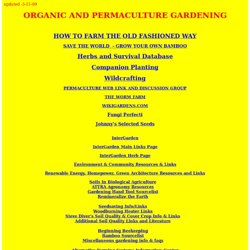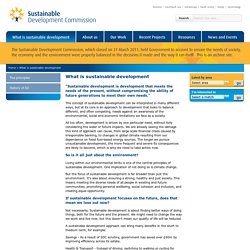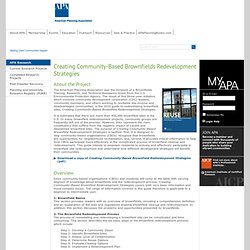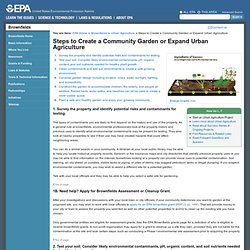

Holy Land Trust - Home. Sharing Films, Media and Educational Materials About Interconnectedness. Promoting the emergence of a sustainable, green, ethical and a just economy worldwide. Browse: Publications. COPs Wiki. Schedule: Bright Green Future Conference 2011: San Diego's Own Sustainability Conference. Green Festival - Admission. Mindshare - The Global Media Network. DREAMS OF THE GREAT EARTH CHANGES. ORGANIC AND PERMACULTURE GARDENING. Glossary of Soil Science Canadian Soil Information System (CanSIS) Eastern Cereal and Oilseed Research Centre Ottawa (Ontario) Solstice from the Center for Renewable Energy and Sustainable Technology ( CREST) larsenfamily.com InterGarden Permaculture Resources and Discussion Forums | InterGarden Permaculture | EcoLandTech Landcare U.S.

ATTRA On-Line - Appropriate Technology Transfer for Rural Areas The national sustainable farming information center at the University of Arkansas at Fayetteville. ICARDA - The International Center for Agricultural Research in the Dry Areas Internet Apiculture and Beekeeping Archive Pest Management at the Crossroads | Charles Benbrook - Benbrook Consulting Services The Sustainable Farming Connection Ralph Nader's PUBLIC CITIZEN ENVIRONMENTAL WORKING GROUP | E-mail E.W.G. Ceres Online - The Business of Agriculture - Agsearch, Weblinks, Ag Weather DejaNews Newsgroup Archive Site GardenWeb EnviroLink Arizona Biological Control, Inc. Awaken! SeaGrass Contents Successful Farming. Innovation & Economic Development. Rainwater Harvesting for Drylands and Beyond by Brad Lancaster. The Center for Pattern Literacy – Toby Hemenway. DeeMee's review of Prosperity without Growth: Economics for a... Prosperity without Growth: Economics for a Finite Planet (9781844078943): Tim Jackson.
What is sustainable development · Sustainable Development Commission. "Sustainable development is development that meets the needs of the present, without compromising the ability of future generations to meet their own needs.

" The concept of sustainable development can be interpreted in many different ways, but at its core is an approach to development that looks to balance different, and often competing, needs against an awareness of the environmental, social and economic limitations we face as a society. All too often, development is driven by one particular need, without fully considering the wider or future impacts. We are already seeing the damage this kind of approach can cause, from large-scale financial crises caused by irresponsible banking, to changes in global climate resulting from our dependence on fossil fuel-based energy sources. The longer we pursue unsustainable development, the more frequent and severe its consequences are likely to become, which is why we need to take action now. So is it all just about the environment? Not necessarily. Gallup-Healthways Well-Being Index. Creating Community-Based Brownfields Redevelopment Strategies. About the Project The American Planning Association was the recipient of a Brownfields Training, Research, and Technical Assistance Grant from the U.S.

Environmental Protection Agency. The result of this three-year initiative, which involved community development corporation (CDC) leaders, community members, and others working to revitalize low-income and disadvantaged communities, is the 2010 guide to redeveloping brownfield sites, Creating Community-Based Brownfield Redevelopment Strategies. It is estimated that there are more than 450,000 brownfield sites in the U.S. In many brownfield redevelopment projects, community groups are frequently left out of the process. MP906 Community Gardening Toolkit. Steps to Create a Community Garden or Expand Urban Agriculture. 1.

Survey the property and identify potential risks and contaminants for testing. The types of contaminants you are likely to find depend on the history and use of the property. As a general rule at brownfields, environmental professionals look at the property history and previous uses to identify what environmental contaminants may be present for testing. They also look at nearby properties to see if their use may have created hazards that could affect neighboring areas. You can do a similar search in your community. Talk with your local officials and they may be able to help you select a safer site for gardening.
Top of page 1B. After your investigations and discussions with your local town or city officials, if your community determines you want to garden at the proposed site, you may wish to work with local officials to apply for an EPA brownfield grant (PDF) (2 pp, 148K). Only governmental entities are eligible for assessment grants. 2. 3. 4. 5. 6. Model Policy: Establishing Land Use Protections for Community Gardens. Garden Mosaics: Garden Science, Intergenerational Learning, Action Learning, Multicultural Education. Resources & Related Links. Success Stories & Ongoing Projects. Final-report_low-res.pdf (application/pdf Object) Soil Quality and Testing - Cornell Waste Management Institute.